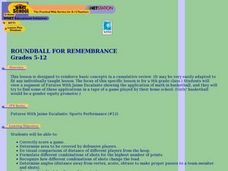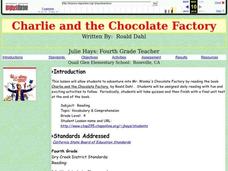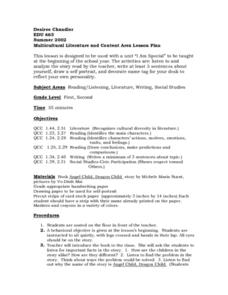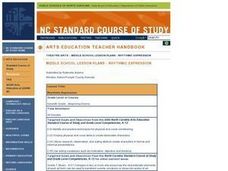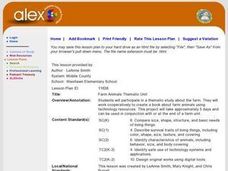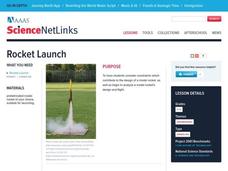Curated OER
Roundball for Remembrance
Students view a segment of Futures With Jaime Escalante showing the application of math in basketball, and they try to find some of these applications in a tape of a game played by their home school. This fun lesson should be very...
Curated OER
Energy Eccentricity
Students assess their own energy use to help develop an awareness of the different types of natural resources affected by consumers. Their calculations show them how much they are personally impacting the Earth. Very meaningful and...
Curated OER
Charlie and the Chocolate Factory
Fourth graders read and take quizzes over the book, Charlie and the Chocolate Factory.
Curated OER
Pennsylvania Colony
Students research the main reasons for the colonists moving to the Pennsylvania colony. They analyze maps, label a bubble map, list similarities/differences of immigrants then and now, and create a colonial newspaper advertisement.
Curated OER
Camouflage
Third graders collect insects and various bits of the insects' habitats in order to develop an understanding of how camouflage makes the insect fit to survive in its environment.
Curated OER
Intolerable Acts
Students examine the implications of North Korea's nuclear testing. They develop a K-W-L chart, read an article, write questions, conduct research on their self-generated questions, and create an exhibit of their findings.
Curated OER
How Do White Blood Cells Fight Foreign Organisms That Invade Our Body?
Ninth graders investigate the functions of white blood cells. They watch and discuss an online movie, conduct Internet research, and complete a worksheet.
Curated OER
Trichinella Forensics
Students engage in DNA manipulation using forensics techniques. Students investigate topics involved in forensics studies such as cloning, electrophoresis, gene mapping, replication, and transcription.
Curated OER
The Physics of Sound: How We Produce Sounds
Young scholars are introduced to how they produce sounds. In groups, they participate in experiments in which they measure sound and identify their five senses. Individually, they make their own musical instruments using different...
Curated OER
"Angel Child, Dragon Child"
Students read and analyze the book "Angel Child, Dragon Child" by Michele Maria Surat. They chart the main story elements on a graphic organizer, and write three sentences about themselves and draw a self-portrait. Students then create...
Curated OER
SHAKESPEARE IN TODAY'S WORLD
Students, after an introduction to Shakespeare's "Othello," compare/contrast the themes in the play to today's society. In addition, they write their own script for the play of "Othello" based on predictions of what they think will...
Curated OER
Ladybugs
Third graders keep and report records of investigations and observations of ladybugs utilizing tools like journals, charts, graphs and computers. They discover and study the life cycle of ladybugs and complete a KWL chart about ladybugs.
Curated OER
Three Branches of Government
Fourth graders listen to a lecture about the government of Indiana, and the three branches of government. They discuss the reasons for the three branches and read from their text the information on government. Students play a game to...
Curated OER
Foil tooling - Oriental Art
Students view examples of copper tooling. They create a sketch the size of their copper. Students tape the top and bottom of the sketch to their copper and place a stack of newspaper under the copper. They trace all lines of their sketch...
Curated OER
Rhythmic Expression
Students discover movement and expression to music/sound through a series of teacher-led exercises and role plays. This lesson is ideal for the middle school drama class with possibilities for adaptation to any level of drama or general...
Curated OER
Farm Animals Thematic Unit
Student study farm animals by watching a teacher made PowerPoint presentation and visiting a farm. They research a farm animal with teacher assistance. They design a book about the animals using available technology and orally present...
Curated OER
Gene Puzzles
Students come to understand that in sexually reproducing organisms, such as humans, typically half of the genes come from each parent.
Students examine a fictional pedigree and determine which gene is responsible for a given trait. The...
Curated OER
The Sun
Students draw diagram of sun and its layers, including photosphere, chromosphere, corona, convection and radiative zones, and core. Students then describe each layer in their own words, define sun spot cycle, and describe solar flares.
Curated OER
Acid Stomach
Students develop an understanding of how aspirin works and how understanding it's interaction with other chemicals in the body aided doctors in medical research. They complete a lab that compares the reaction of regular aspirin and...
Curated OER
Rocket Launch
Students consider constraints which contribute to the design of a model rocket. They begin to analyze a model rocket's design and flight. They must be very specific in their thoughts and discussions.
Curated OER
About the Author: Kate DiCamillo
Young scholars examine the writing process of Kate DiCamillo, the author of "Because of Winn-Dixie." They read author's comments, watch a slideshow narrated by the author, complete a free-write activity, and discuss Kate DiCamillo's top...
Curated OER
Food Chains
Students study food chains by creating their own slide show using KidPix. They compare information after sharing their slide shows as a whole group. As the children are watching the slide shows of their peers, they tally every time...
Curated OER
'Neuro-Bingo'
Young scholars discuss the nervous system and its pathology. They are then able to explain what neural physiology is. They use this game to further help them to develop clear meaning of the nervous system.
Curated OER
Post Civil War Reconstruction
Students analyze the process of Reconstruction after the Civil War. In this U.S. History instructional activity, students discuss specific details about Reconstruction with the class, then complete a worksheet with multiple...
